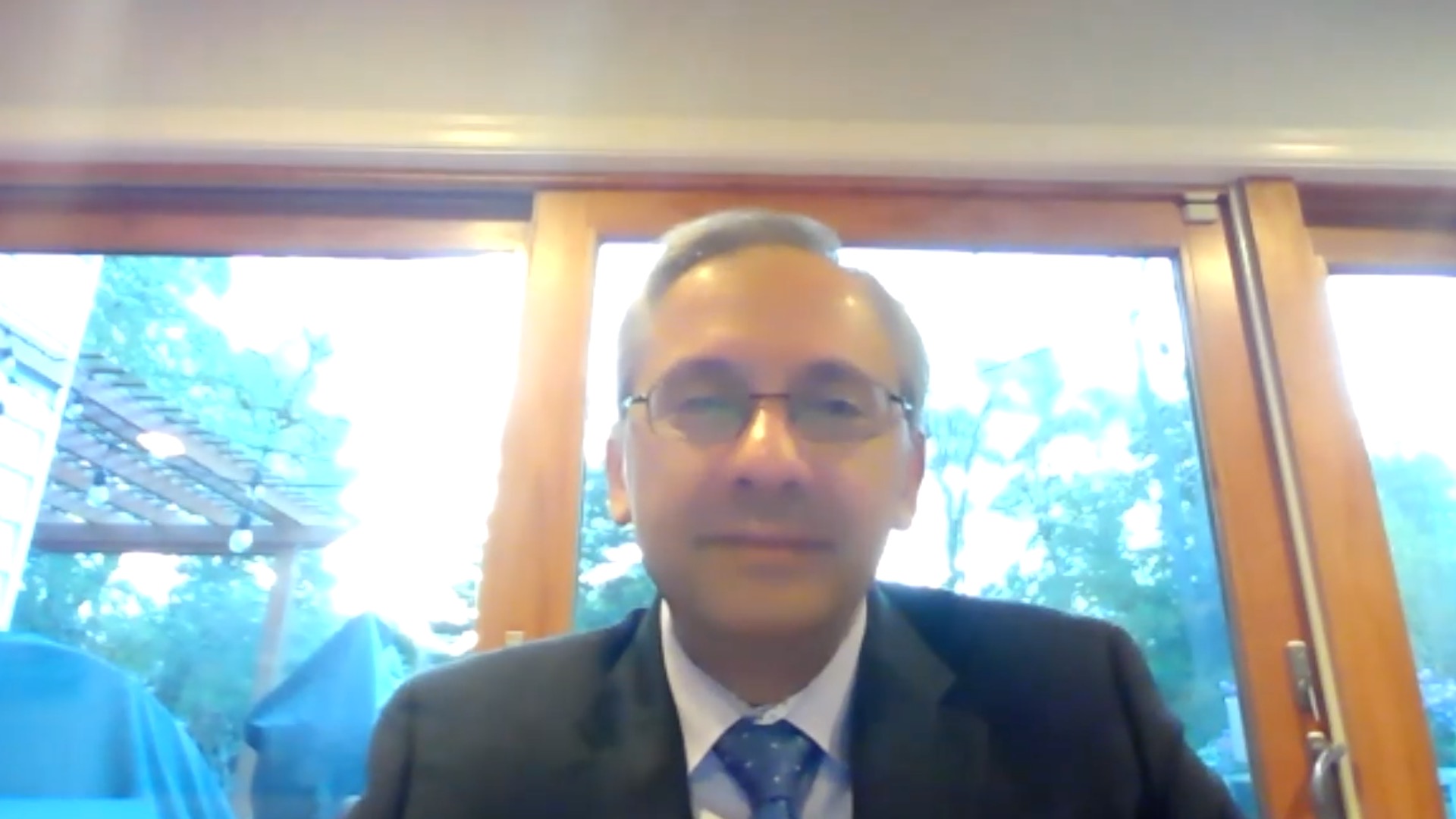Michael Pishvaian, AACR 2023: TIGeR-PaC phase III trial, intra-arterial gemcitabine for patients with locally advanced pancreatic cancer
Treatment of locally advanced pancreatic cancer has really primarily consisted of systemic intravenous chemotherapy. The TIGeR-PaC trial is aiming to assess if an alternative treatment mode, intra-arterial delivery of gemcitabine, improves overall survival. In this touchONCOLOGY interview, we speak with Dr Michael Pishvaian (Johns Hopkins University School of Medicine, Baltimore, MD, USA) to discuss the TIGeR-PaC phase III trial interim analysis.
The abstract entitled ‘Targeted intra-arterial gemcitabine vs. continuation of IV gemcitabine plus nab-paclitaxel following Induction with sequential IV gemcitabine plus nab-paclitaxel and radiotherapy for unresectable locally advanced pancreatic cancer (TIGeR-PaC) – phase III trial interim analysis’ (Abstract CT084) was presented at the American Association for Cancer Research Meeting 2023, 14–19 April 2023.
Questions:
- What are the benefits of using a localized dual-balloon-mediated, intra-arterial delivery of gemcitabine (IAG) versus an intravenous method? (0:17)
- What are the aims, design, and eligibility criteria of the study? (2:18)
- What was the primary endpoint and how well was it achieved in this interim analysis? (4:36)
- What will be the likely place of local double balloon mediated delivery of intra-arterial gemcitabine (IAG) in the treatment paradigm for locally advanced pancreatic cancer? (5:51)
Disclosures: Micahel Pishvaian is on the advisory board for Astellas, Pionyr and Trisalus and a consultant for Astra Zeneca, Ideaya, Merck, Merus and Seattle Genetics. He has received grant/research support from Amgen, Arcus Bio, Astellas, AstraZeneca, Bayer, Biomed Valley Discoveries, BMS, Boerhinger Ingelheim, Caris, EISAI, Exelixis, Foundation Medicine, Hutchinson Medipharma, Ideaya, Incyte, Ipsen, Merck, Natera, Novartis, Pfizer, RenovoRx, Repare Tx, SeaGen, Seattle Genetics, Taiho, Takeda, Tempus, Tizonia and Tesaro. He is a major stockholder in Perthera.
Support: Interview and filming supported by Touch Medical Media. Interview conducted by Danielle Crosby.
Filmed as a highlight of AACR 2023
Access more content on Pancreatic Cancer here
Transcript:
My name is Mike Pishvaian, I’m an Associate Professor in Medical Oncology at Johns Hopkins University School of Medicine.
Q. What are the benefits of using a localized dual-balloon-mediated, intra-arterial delivery of gemcitabine (IAG) versus an intravenous method?
Treatment of localized pancreatic cancer has really primarily consisted of systemic chemotherapy. There has never really been any proof that local therapy, particularly radiation therapy, has extended the overall survival. In fact, there have been several large phase III randomized studies that have been done, including most recently the LAP07 study that taught us that the addition of localized radiation did not actually improve overall survival. So we have been primarily left with systemic chemotherapies.
Now it makes sense that we would want to treat the tumour in the pancreas where it is localized and certainly for other disease types. Treating a localized disease can also help improve outcomes in patients. I think with pancreatic cancer, the challenge has really just been how do you safely and effectively treat the local tumour in the pancreas without causing undue toxicity and in a way that actually improves the overall treatment for the cancer? So one approach, that is being tried in this study, is to try and use this double balloon method to isolate the blood vessel nearest to the tumour and enhance the pressure of the intra-arterial gemcitabine that is being delivered. Therefore, it can more effectively get to the tumour in the pancreas. The premise of this is that intra-arterial pressure for pancreatic tumours is very high, something that has been known for 15 or 20 years, and there is a challenge that when the intravenous (IV) chemotherapy is given through the blood vessel, that the drug does not get delivered as effectively to the tumour because of that high interstitial intra-arterial pressure in the area of the tumour. Therefore, by using this double balloon method to clamp off the artery surrounding the tumour and enhance the pressure, some nice studies have shown in animal models and as well in patients that you can actually get delivery of more drug to the tumour in that way. The hope would be that a higher drug concentration to the tumour would lead to an increased tumour cell death.
Q. What are the aims, design, and eligibility criteria of the study?
Based on the premise of trying to increase intra-arterial pressure and increased delivery of the chemotherapy to the tumour, the study was designed with a simple design in mind, meaning that it was meant to be real world applicable.
First, the study was designed to capture patients with locally advanced unresectable pancreatic cancer, as defined by NCCN guidelines. Then patients were eligible if they had pancreatic adenocarcinoma, but also fit standard eligibility criteria such as normal hepatorenal function. Although I will say that the trial was modified during the course of the years to allow patients who presented with biliary obstruction and had an elevated bilirubin to receive a single dose of chemotherapy outside of the study before they became eligible and then can be part of the study once their bilirubin normalized. That unique aspect actually captures more patients who would be potentially study eligible. In any case, patients who had localized disease, normal hepatorenal function and were able to have a good performance status proceeded.
The treatments were then given standard of care gemcitabine nab-paclitaxel, which is a routine and appropriate treatment for patients with localized disease. The patients were also enrolled to receive radiation therapy as well, again under standard practice. The randomization then occurred after 4 months of induction therapy, when patients were shown to have at least stable, if not improved disease for their pancreas cancer. Then the randomization would be to 4 months of intra-arterial gemcitabine given every 2 weeks or continuation of gemcitabine and nab-paclitaxel intravenously, as was happening for the patients during their induction treatment period.
The design of the study really was to see if the use of intra-arterial gemcitabine improved overall survival. The trial did shoot for that most definitive endpoint of overall survival. There are a number of secondary endpoints that are also important: progression free survival, response rates, rendering patients operable, as well as a number of safety assessments, including tolerability and quality of life assessments.
Q. What was the primary endpoint and how well was it achieved in this interim analysis?
The primary endpoint of the study was overall survival to see if the use of intra-arterial gemcitabine actually led to an improved survival rate for patients with locally advanced pancreatic cancer.
This presentation at AACR was just an interim analysis. The study is ongoing, but at the interim analysis, there was an improvement in median overall survival with the use of intra-arterial gemcitabine compared with just continuation of IV gemcitabine nab-paclitaxel. The degree of benefit/the magnitude of benefit was 6 months. There was a median overall survival of 6 months for patients who received intra-arterial gemcitabine versus only 10 months for patients who received continuation of gemcitabine nab-paclitaxel.
It is important to emphasize that those numbers, 6 and 10 months, are from the time of randomization. Therefore, patients have already received 4 months of induction therapy prior to the point of randomization. That interim analysis is going to be followed by additional interim analyses as defined by the protocol. One readout is expected at the end of this calendar year and then hopefully the final overall survival results will be in 2024.
Q. What will be the likely place of local double balloon mediated delivery of intra-arterial gemcitabine (IAG) in the treatment paradigm for locally advanced pancreatic cancer?
Of course, I want to be careful about not overstating the results just because this was an interim analysis and the nature of pancreatic cancer for decades now has been that sometimes these trials disappoint us, despite a lot of excitement. But certainly I am hopeful that this will lead to a final overall survival demonstration with the use of intra-arterial gemcitabine for localized pancreatic cancer, and then to think forward as to where we might use this therapy. Itis pretty straightforward because for patients who get systemic therapy for pancreatic cancer, whether metastatic or localized, their disease never becomes operable. These patients actually, for the most part, continue chemotherapy and the week after week or every other week, continuation of chemotherapy can actually be difficult on patients for a year or 2 years or 3 years. Obviously, the longer you are treating them, the better their survival is. Of course, that is better for patients, but to be able to integrate other therapies that might give the patients a little bit of a break, and hopefully to do so in a way that is proven to improve the overall survival, would be fantastic. So my paradigm, and again this is premature, but my paradigm and how I might adopt this kind of therapy, for example, would be to really follow the protocol to give patients a period of chemotherapy, to potentially incorporate radiation therapy for the appropriately selected patient. Then once they start getting kind of beat up with continuation of chemotherapy, which tends to happen at about 4 to 6 months, patients are looking for a break in their therapy. For us to be able to say, we are going to take a break from IV chemotherapy and do this intra-arterial chemotherapy every other week, which, by the way, we hope will improve overall survival once the study results come out. But really actually gives the patient the benefit of being able to be off this IV chemotherapy for a period of time.
The intervention radiologists who do these procedures actually find them pretty straightforward in the way that they do the procedures. So that has not been a particular challenge. So to be able to incorporate this even in the community, should be fairly seamless when the time comes. Of course, if the time comes that the study ends up positive.
Subtitles and transcript are autogenerated






